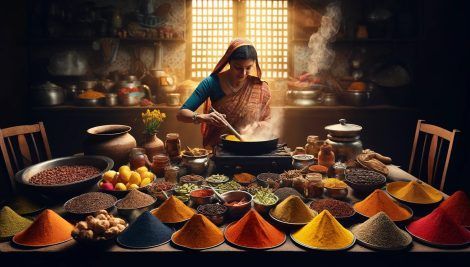- You have no items in your shopping cart
- Subtotal: ₹0.00
Udupi Cuisine History

Udupi cuisine is taking the world by storm with its rich traditional excellent food. If you had the chance of tasting authentic Udupi food, you will realize that the item is not just a portrayal of a culinary skillset. It is an experience of goodness that lasts forever.
The use of pure Indian spices is one of the distinguishing characteristics of Udupi cuisine. Let’s share more information about the historic origin of the cuisine to help you learn about the deep-rooted traditional heritage behind the outstanding recipes of the cuisine.
From temples to restaurants
Many centuries ago, Madhavacharya established the form of Krishna Matt. It is based on Vaishnav principles and the Shivalli Brahmins who were his disciples, managed and served the cult. And this eventually became the core of a religion and more importantly, the seed of an entirely new culinary world.
Rise of Madhava cuisine
Madhava cuisine has been the base for the development of Udupi cuisine. This cuisine showcased the Vedic principles strictly and became the epitome of culinary exclusion. The Matt cuisine banned the use of onion, garlic, carrots, tomatoes, radish, beans, cabbage, papaya, cauliflower, beetroot, spinach, gherkins, brinjal, basale, and drumsticks.
But by the end of the 20th century, Udupi became the representation of South Indian food. And people started to accept the food form owing to features like
- Delicious in taste
- Gives a feeling of fullness
- Nutritious
- Easy to prepare
So, what do you think was the reason for the sudden popularity of the Udupi cuisine that continues to grow even today?
A story of modernization
Udupi has been always a food culture that existed within the temple premises. Udupi had been the site of Vedic learning. There were two temples present in Udupi- Sri Candramauleshvara and Sri Ananteshvara. While the former is the temple, of Shiva, the latter is the temple of the companion of Shiva.
When madhavacharya started to learn the tradition in Udupi, he planned to build a temple that will honor the idol of the child Lord Krishna. And this led to certain modernization of the existing cuisine which exhibited the first signs of modern influence in the culinary aspects.
The Shivalli brahmins have been the sevaks of the Krishna temple. So, the first prasad that the Shivalli Brahmins cooked in the Krishna temple was a mixture of the masala podi cuisine and the old Udupi cuisine. Back in those days, each temple exhibited unique cuisine that ultimately became the distinguishing feature of the temple itself.
The food for humans and Gods
The Brahmins believed that gods and goddesses like to have the same food as humans. So, the priests treated traveling far and wide to learn new cooking styles and new dishes. Studies show that the sevaks had to travel mandatorily all across Udupi and beyond for the propagation of vaishnavite culture and exchanging recipes for vegetarian dishes.
Modifying chaturmasya vrata
Once the travelers got a new idea of preparation, they used to bring it back to the temple, experiment further and recreate the recipe with some minute or significant changes. The sevaks followed chaturmasya Vrata where they had to give up eating certain ingredients during a particular period of the year.
And this helped them to start thinking out of the box for these periods. Horse gram was the only pulse in use during the vrata and pepper and mango were the only spices to use from July to mid-August. So, limitations gave rise to the development of more interesting pure Indian spices.
Influence of shepherd caste
When Sri Vaadiraja included the shepherd caste into the ideology in the 16th century, the matt became the meeting point for visitors from different castes and creeds. And this kept on adding little things to the cuisine that were earlier not allowed.
For instance, the use of mango for aiming the curry sour was a new technique to avoid the use of tamarind as it was not allowed. And you cannot negate the influence of the coastal area on the cuisine’s style.
Spreading to new areas
Udupi suffered from a massive flood in 1923. The natural calamity compelled many cooks to shift their base to other cities like Mumbai and Chennai. And they started the Udupi restaurant in these new cities. Of course, the wholesome foods at reasonable rates immediately caught the attention of the mass.
A global expression
Udupi Kitchen played a significant role in spreading the goodwill of the cuisine further. It is the era of quick cooking and instant foods. So, we have successfully packed the goodness of all Udupi spices into small packages to make sure that all of you can cook some Udupi food right at your home.
You can now buy Indian spices online from our site to enjoy Udupi food without visiting the restaurant or the city. Our authentic spices will make history come alive on your lunch plates.





